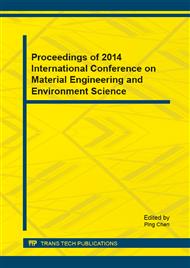[1]
S Sadhu, P Saha, S Mayilraj, et al. Lactose-enhanced cellulase production by Microbacterium sp. isolated from fecal matter of zebra (Equus zebra). Current microbiology, 62(2011) 1050-1055.
DOI: 10.1007/s00284-010-9816-x
Google Scholar
[2]
C Thulluri, B R Goluguri, R Konakalla, et al. The effect of assorted pretreatments on cellulose of selected vegetable waste and enzymatic hydrolysis. Biomass and Bioenergy, 49(2013) 205-213.
DOI: 10.1016/j.biombioe.2012.12.022
Google Scholar
[3]
J Bian, F Peng, X P Peng, et al. Effect of [Emim] Ac pretreatment on the structure and enzymatic hydrolysis of sugarcane bagasse cellulose. Carbohydrate polymers, 100(2014) 211-217.
DOI: 10.1016/j.carbpol.2013.02.059
Google Scholar
[4]
G Tokuda, H Watanabe. Hidden cellulases in termites: revision of an old hypothesis. Biol. Lett, 3(2007) 336-339.
DOI: 10.1098/rsbl.2007.0073
Google Scholar
[5]
M. G. Adsul, B K. B. astawde, A. J. Varma, et al. Strain improvement of Penicillium janthinellum NCIM 1171 for increased cellulase production. Bioresource Technology, 98 (2007) 1467–1473.
DOI: 10.1016/j.biortech.2006.02.036
Google Scholar
[6]
J. Kaur , B. S. Chadha, B. A. Kumar, et al. Purification and characterization of two endoglucanases from Melanocarpus sp. MTCC 3922. Bioresource Technology, 98(2007)74–81.
DOI: 10.1016/j.biortech.2005.11.019
Google Scholar
[7]
A. Berlin, N. Gilkes, D. Kilburn, et al. Evaluation of cellulase preparation for hydrolysis of hardwood substrates. Applied Biochemistry and Biotechnology, 129 (2006)528–545.
DOI: 10.1385/abab:130:1:528
Google Scholar
[8]
A. Walia, P. Mehta, A. Chauhan, et al. Optimization of cellulase-free xylanase production by alkalophilic Cellulosimicrobium sp. CKMX1 in solid-state fermentation of apple pomace using central composite design and response surface methodology. Ann Microbiol, 63 (2013).
DOI: 10.1007/s13213-012-0460-5
Google Scholar
[9]
SA Malik, F Manzoor, BM Ahmed. Laboratory and field evaluation on the natural resistance and feeding preference of different wood species to Subterranean termites (Isoptera: Rhinotermitidae, Termitidae) in Pakistan. The International Research Group on Wood Protection, IRG/WP 12–10769(2012).
Google Scholar
[10]
H. König, L. Li, J. Fröhlich. The cellulolytic system of the termite gut. Appl Microbiol Biotechnol , 97(2013)7943–7962.
DOI: 10.1007/s00253-013-5119-z
Google Scholar
[11]
L Li, J Fröhlich, H König. Cellulose digestion in the termite gut. In: König H, Varma A (eds) Intestinal microorganisms of termites and other invertebrates. Springer, Heidelberg, 2006, p.221–241.
DOI: 10.1007/3-540-28185-1_9
Google Scholar
[12]
H Watanabe, G Tokuda . Animal cellulases. Cell Mol Life Sci , 58(2001) 1167–1178.
DOI: 10.1007/pl00000931
Google Scholar
[13]
S A Jabasingh, C ValliNachiyar. Optimization of cellulase production by Aspergillus nidulans: application in the biosoftening of cotton fibers. World Journal of Microbiology and Biotechnology, 27(2011) 85-97.
DOI: 10.1007/s11274-010-0431-6
Google Scholar
[14]
B. Adney, J. Baker, Measurement of cellulase activities. LAP-006 NREL laboratory analytical procedure. Golden: National Renewable Energy Laboratory (1996).
Google Scholar
[15]
G. L. Miller, Use of dinitrosalicylic as reagent for the determination of reducing sugars. Analytical Chemistry, 31(1959) 426–428.
DOI: 10.1021/ac60147a030
Google Scholar


